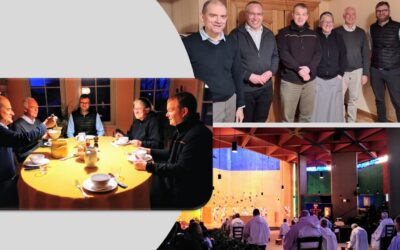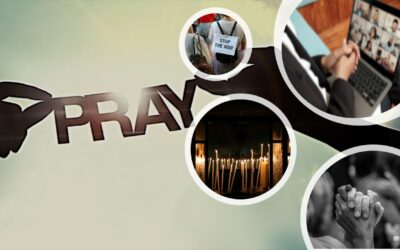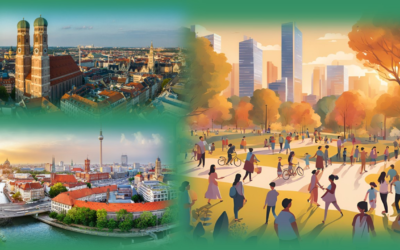It´s a matter of growing ever more into a “culture of trust”, including a worldly trust in God.
Herbert Lauenroth’s presentation at the International Congress of “Together for Europe – Munich 2016″ is as current as ever. Here is the full text.
Dear friends,
I would like to start my – rather fundamental – reflections on the subject of fear, fear in Europe, with two striking biblical respectively secular images:
1 In a dramatic moment in the book of Genesis God calls man: “Where are you, Adam?” This call is addressed to the one who has sought refuge in the underbrush, full of shame and driven by fear. To the one hiding from the sight of God because he has become aware of his existential nakedness and wretchedness. This image depicts the present situation in Europe in a quite drastic way: A continent barricading and entrenching itself in its seemingly hopeless presence. Europe is hiding in the underbrush, stuck in the entanglements of its own limitations and a history of guilt. This underbrush is Idomeni, the Macedonian border, the barbed-wire fence at the Hungarian-Serbian border, but also the various exclusions in society.
If we read the biblical scenario as for turning Europe into a fortress, a measure against migrants, it allows another different reading: It´s the European sovereign standing before us, it´s his exposure and homelessness we`re looking at. He is the real refugee, trying to escape from himself, the most fatal of all flights. Therefore Europe has to hear this call from the Biblical God once again. It´s a question of its destiny, mission and responsibility for itself and the world: “Adam/Europe, where are you?”
2 This image of an existential narrowness God calls out of, finds its counterpart in the visions of men`s cosmic forsakenness in an indifferent, inhospitable universe. Philosopher and mathematician Blaise Pascal expressed it like this: “The eternal silence of these infinite spaces terrifies me!” It´s about a sense of being appalled or exposed that frightens man, as he is isolated and being thrown back on his own. In European history this recurring theme has been described as “loss of the center” or “transcendental homelessness”.
3 However, this fear of loss of self and the world can make room for new experiences at the same time: Czech poet and President Vaclav Havel, looking back on the peaceful revolutions in Eastern Central Europe in 1989/90, spoke of fear as “fear of freedom”: “We were like prisoners who had become accustomed to the prison, and then, being released to the long-desired freedom out of the blue, did not know how to deal with it and became desperate because they constantly had to decide on their own and take responsibility for their own life.” It is, according to Havel, to face this fear. This is how it “enables us to acquire new abilities: The fear of freedom can be exactly what teaches us to fulfil our freedom. And fear of the future can be exactly what forces us to do everything to make the future better.”
Finally, the great protestant theologian Paul Tillich takes fear for the basic experience of human existence: “The courage to be,” he writes, “is rooted in the God who appears when God has disappeared in the fear of doubt.” This means: only the experience of fear – as the loss of an image of God, man and the world that was formerly formative and considered to be immutable – unleashes what is called the “courage to be“. The true – divine – God appears so to speak in the heart of fear, and he alone causes de-frightening. In turn this experience leads man to deeper experiences and horizons of being. God reveals himself in the supposed facelessness and ahistoricity of the world as the face of the other.
4 It is therefore necessary to descend into these ‘inner rooms of the world’ of biographical as well as collective fears and experiences of loss, in order to meet the God who saves us. Two examples:
4.1 Yad Vashem: my visit to the Shoah memorial site last autumn is an unforgettable experience for me: I walk through the mazy-like architecture as if in a daze and finally reach the Children`s memorial, a subterranean space where the light of burning candles is reflected by mirrors. It`s a dark resonance space of bodiless voices, which unceasingly recall the elementary life-data of the innocent victims and I feel a new, deep solidarity – especially in view of this profound primal fear of not only being physically destroyed, but being even eliminated from the cultural memory. The testimony of this place becomes my own experience: to provide a place for the lost name, to preserve a memory for the name of God and its creatures. My guestbook entry is a sentence of the prophet Isaiah that expresses both my consternation and the new hope in the captive closeness of a fatherly God: “Fear not, for I have redeemed you. I called you by name, you are mine!” (Isaiah 43,1)
4.2 In view of the great European tales of fear, Czech philosopher and theologian Tomáš Halík describes a similar experience: “We do not build the bold project of European unity on unknown ground or wasteland. We build it on a ground, in whose layers forgotten treasures and burned debris are stored, where gods, heroes and criminals are buried, rusted thoughts and unexploded bombs. From time to time we have to set out on looking into the depths of Europe, into the underworld, like Orpheus to Eurydice, or the dead Christ to Abraham and the fathers of the Old Testament.”
5 For me, these various “descents into the depths of fear” converge in the description of the baptism of Jesus in the Gospel of Matthew: “As soon as Jesus was baptized, he went up out of the water. At that moment, heaven was opened, and he saw the Spirit of God descending like a dove and lighting on him. And a voice from heaven, said, ‘This is my Son, whom I love; with him I am well pleased.’“ (Matthew 3:16–17)
We have to descend with Christ to reach that point of origin, above which the sky opens up quite surprisingly. It´s where God’s law of life shows itself: “What comes from above must grow from below.” In this way, in, with and through Jesus, the “fraternal” community of solidarity is formed, in which the individual members do not only recognize themselves as “sisters and brothers” but also as “sons and daughters of God”, in which “dignity of man” and “God-likeness” form an indivisible unity.
6 In his book “Letters and Papers from Prison” (Widerstand und Ergebung) Dietrich Bonhoeffer describes the core of the Christian identity as a response to the question of Jesus at the moment of his mortal fear in Gethsemane: “Could you not watch with me one hour?” (Matthew 26,40) – It is an invitation to the night watch at the side of Jesus, in his presence facing the Father, in a secular – supposedly godless – world. This presence of Jesus transforms different locations into places of experience and expectation of Trinitarian life.
7 In this key section of the Gospel of Matthew “fear” appears as a privileged place of learning for our faith where diffuse, “blind” fears converge and transform into the authentic “fear of God” of Jesus that offers new insights.
As:
- In, with, and through Jesus, de-frightening takes place as a real frightening-through of man towards God: The supposed exposure of the Son changes to devotion to the Father.
- Unity grows as an experience of mutual trust. It grows from sensitivity for the mystery of God which is not at our disposal, the otherness (alterity) of the other. French-Jewish philosopher Simone Weil expresses this experience in a striking way: It´s only the unconditional “consent to the distance of the other” that allows for authentic closeness and communion with God and man.
- So that´s what it is about: Preferring the unknown, the unfamiliar, the marginalized – as a “learning place” of faith – in, with, and through Jesus.
- This especially applies to the different charisms and their communion: in Paris in November 2013 at a meeting of Together for Europe with Jean Vanier, founder of “L’Arche”, it became apparent to us: one of the real aims of the charisms is also to receive the “charism of the world” and to reflect it to this world. Vanier’s testimony has been very impressive: primarly it´s not about living with and for the “addressees” of the Beatitudes of Jesus, but from In fact they – the supposedly needy and receiving ones – are the God-gifted and giving ones. They are the bearers of a message, a presence of God that has to return to the center of our societies from their margins. Klaus Hemmerle, Bishop of Aachen and religious philosopher wrote concisely: “Let me learn from you the message that I have to pass to you”.
8 This attitude, however, requires a “thrust reversal”, a true metánoia of many a Christian on their understanding of themselves and the world. It calls for a new faith in God’s love for the world which is revealed in Christ. It´s a matter of growing ever more into a “culture of trust”, including a worldly trust in God that is founded in Jesus.
9 Looking up into the dome of the Circus-Krone building, we might think of some trapeze artists. For me, they are the true artists of de-frightening: Flyers hovering in the air, always taking the risk of trust, letting go and stretching out again for future spaces. An artistic moment in that prophetic and always fragile, risky intermediate state of “grace and gravity”: The grace of weightlessness, yet the creature always having a knowledge of being held and secure, in a certain sense “redeemed” from itself and liberated for turning towards the other.
With this in mind, Henri Nouwen writes: “A flyer must fly, and a catcher must catch, and the flyer must trust, with outstretched arms and open hands that his catcher will be there for him. […] Remember that you are the beloved child of God. He will be there when you make your long jump. Don’t try to grab him; he will grab you. Just stretch out your arms and hands – and trust, trust, trust! “
Herbert Lauenroth, Ecumenical Center Ottmaring (Germany), in Munich, Circus-Krone-Bau, 01/07/2016
Photo: trapeze artists ©Thierry Bissat (MfG); H. Lauenroth: ©Ursula Haaf





0 Comments